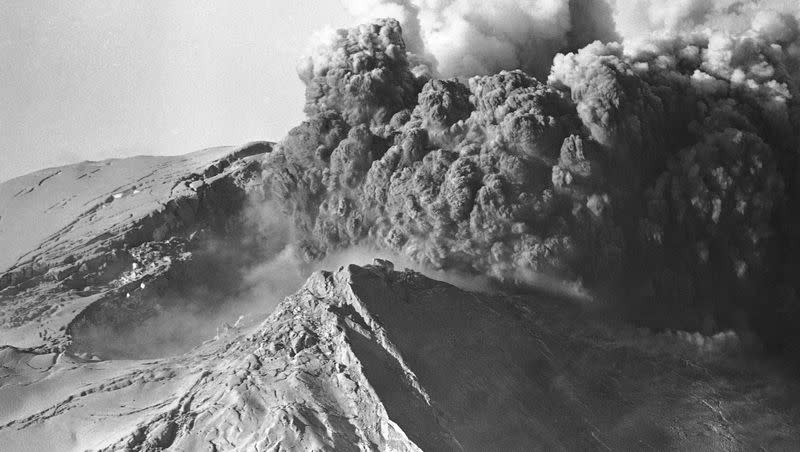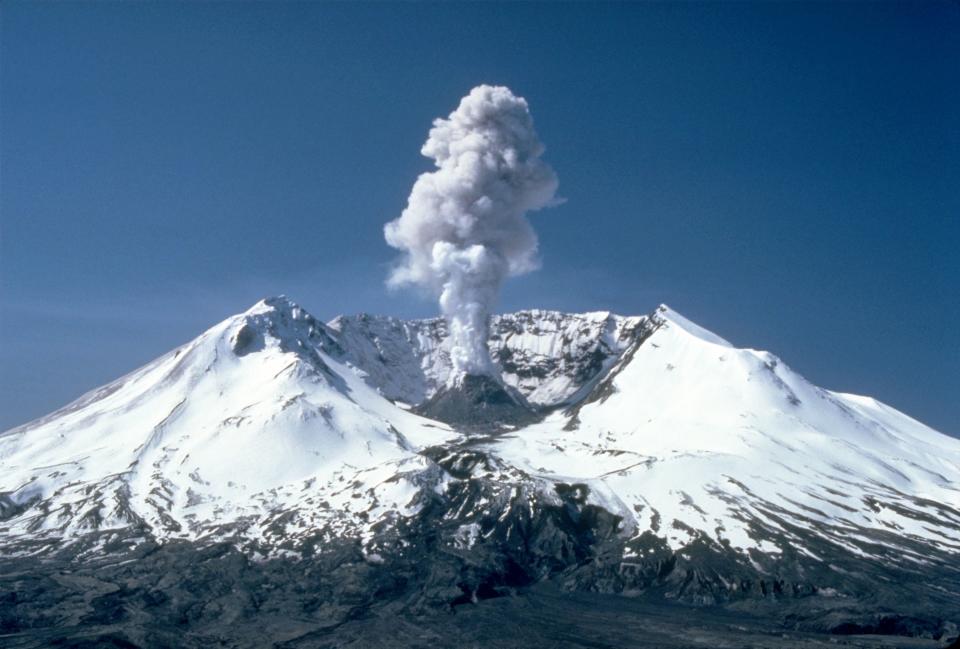The anniversary of Mount St. Helens eruption — did they know it would happen beforehand?

Forty-three years ago, a Plinian eruptive column rose into the sky and volcanic debris rapidly spewed from the volcano. This cataclysmic eruption, which occurred on May 18, 1980, is the most significant volcanic eruption in the contiguous U.S. in recent history.
The 16-mile high column expelled ashes that scattered across several states — stretching from Washington to central Montana, according to Britannica. Fifty-seven people died, thousands of animals were killed and 200 square miles of trees were blown down.
The eruption altered the surrounding landscape. The U.S. Department of Agriculture said, “After the eruption, the summit of Mount St. Helens was gone, forests were obliterated and rivers followed new courses. More than 150 new lakes and ponds were formed, and existing lakes filled with sediment, flooding their banks.”
Volcanoes have erupted several times throughout history, causing various changes. Here’s an overview of how volcanic eruptions happen, a look back at Mount Vesuvius and an update on Yellowstone Caldera.

How do volcanoes erupt?
Volcanic eruptions have to do with magma. According to the American Museum of Natural History, when rocks melt (magma), they rise up because they weigh less than other rocks. Then, this magma continues to collect in magma chambers. Eruptions occur when magma builds up in these chambers and reaches the top.
There are different kinds of volcanic eruptions. The U.S. Department of the Interior said, “The explosivity of an eruption depends on the composition of the magma.” Some volcanic eruptions are not explosive, but others are.
Explosive volcanic eruptions can cause gases to escape and tephra — pieces of magma which range from tiny particles to house-size boulders — to move through the air, per the U.S. Department of the Interior. “Explosive volcanic eruptions can be dangerous and deadly. They can blast out clouds of hot tephra from the side or top of a volcano. These fiery clouds race down mountainsides destroying almost everything in their path.”
Are volcanic eruptions predictable?
Scientists can forecast volcanic eruptions, but volcanoes are unpredictable as their behavior can change. The Smithsonian Institute said scientists monitor volcanic behavior and historic patterns to forecast volcanic eruptions, but “few volcanoes maintain the same behavior for long (more often than not, as soon as a repetitive pattern becomes apparent, the volcano changes behavior).”
There’s also some difficulty in obtaining information about volcanoes. Divya Agarwala said in an article published on the Columbia Climate School website, “Getting instruments on volcanoes can sometimes be difficult because they can be remote, dangerous, or just complicated to work at (e.g., at national parks or private lands).”
Generally speaking, as a volcanic eruption approaches, scientists have a better chance of being able to predict when it’ll occur. According to BBC, “If a volcano was going to erupt in one hour they’d have a good idea it was going to happen. If it was going to blow in a week they’d be less sure, and in six months even less so.”
Scientists are still developing ways to better predict volcanic eruptions.
How many volcanoes still erupt?
The numbers change from year to year. The Smithsonian Institute’s Global Volcanism Project said in 2023, there are 56 active volcanoes with 56 total eruptions. In 2022, there were 80 active volcanoes with 85 total eruptions. In 2021, there were 76 active volcanoes and 81 total eruptions.
Not all volcanoes which have the potential to be active are currently active.
The U.S. Department of the Interior said, “There are about 1,350 potentially active volcanoes worldwide, aside from the continuous belts of volcanoes on the ocean floor at spreading centers like the Mid-Atlantic Ridge. About 500 of those 1,350 volcanoes have erupted in historical time.” Of the 1,350 or so volcanoes, 161 of them are in the U.S.
Where are the 3 largest volcanoes?
The three largest volcanoes (by height) are Mauan Loana in Hawaii, Mount Kilimanjaro in Tanzania and Popocatépetl Volcano in Mexico, according to Statista.
The next largest are Mount Fuji in Japan, Mount Semeru in Indonesia, Etna in Italy, Mount St. Helens in Washington, Mayon Volcano in the Philippines, Mount Bromo in Indonesia, Arenal in Costa Rice and the Maelifell Volcano in Iceland.
Did they know Mount St. Helens was going to erupt?
There were some warning signs Mount St. Helens would erupt. According to Fox Weather, even though scientists were able to detect seismicity which would indicate an eruption, the danger zone around it that Gov. Dixy Lee Ray had ordered turned out to be too small.
From March to May, scientists detected magma building up and a series of earthquakes. According to the National Environmental Satellite, Data, and Information Service, the volcano had remained dormant for over 123 years before the eruption.
By late March 1980, scientists began to see signs of a potential eruption. Fox Weather reported, “The first visible signs of a possible eruption came on March 27, when the first steam and ash explosion opened up a crater 200-250 feet wide and 80-100 feet deep, according to the USGS, That prompted evacuations within a 15-mile radius of the volcano and roadblocks to keep out the curious.”
By April, officials began locking down access to the mountain. According to Fox Weather, on May 17, cabin owners whose cabins were in the red zone were able to pack up their belongings and then leave by the end of the day. The next morning, the volcano erupted.
What happened with Mount Vesuvius?
Due to the historian Pliny the Younger, there’s an existing account of what happened in 79 C.E. when the volcano erupted. While writing to another historian named Cornelius Tacitus, Pliny said, “On August 24, in the early afternoon my mother drew his attention to a cloud of unusual size and appearance ... Sometimes it looked white, sometimes blotched and dirty, according to the amount of soil and ashes it carried with.” He was describing his uncle’s experience — Pliny the Elder.
Pliny described how ashes fell “hotter and thicker as the ships drew near.” He continued, “Meanwhile on Mount Vesuvius broad sheets of fire and leaping flames blazed at several points, their bright glare emphasized by the darkness of night.”
Earthquakes precipitated the eruption. According to the American Museum of Natural History, a major earthquake in 62 C.E. shook the mountain and the magma chamber kept building as earthquakes continued in the area.
The remains of 2,000 people were discovered — their bodies preserved by the ash from the eruption, per History.com. The cities were devastated. “According to Pliny the Younger’s account, the eruption lasted 18 hours. Pompeii was buried under 14 to 17 feet of ash and pumice, and the nearby seacoast was drastically changed. Herculaneum was buried under more than 60 feet of mud and volcanic material.”
What is a Plinian eruption?
Eruptions like the 1980 Mount Saint Helens and Vesuvius are called Plinian eruptions after Pliny the Elder’s description of the Mount Vesuvius eruption, preserved by Pliny the Younger. According to the National Park Service, Plinian eruptions are characterized by ash columns miles high which spread out into an umbrella or mushroom shape.
What happens if Yellowstone erupts?
Underneath Yellowstone National Park, there’s a supervolcano. A supervolcano is a volcanic center whose measured or predicted deposits would be greater than 240 cubic miles, according to the U.S. Department of the Interior.
Supervolcanoes are rare — there are about 20 on the earth, per BBC. They don’t erupt enough, only about once every 100,000 years, but their eruptions can be catastrophic.
Scientists currently don’t think another eruption from Yellowstone will happen, according to U.S. Department of the Interior. It’s erupted three times and currently, there may not be enough magma beneath the caldera for an eruption.
If Yellowstone were to erupt, some of the effects may persist for years after the eruption. The U.S. Department of the Interior said, “Those parts of the surrounding states of Montana, Idaho, and Wyoming that are closest to Yellowstone would be affected by pyroclastic flows, while other places in the United States would be impacted by falling ash (the amount of ash would decrease with distance from the eruption site).” However, an eruption from Yellowstone seems unlikely now.
